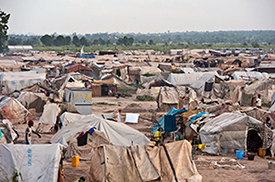 The history of the Central African Republic has been marked by deep-rooted poverty, ethnic tensions, pervasive political instability, corruption and nepotism that led to a succession of armed conflicts. Successive conflicts have spawned multiple peace processes, but as long as impunity reigns, this terrible trajectory – with each armed group committing appalling acts of violence – may continue.
The history of the Central African Republic has been marked by deep-rooted poverty, ethnic tensions, pervasive political instability, corruption and nepotism that led to a succession of armed conflicts. Successive conflicts have spawned multiple peace processes, but as long as impunity reigns, this terrible trajectory – with each armed group committing appalling acts of violence – may continue.
In documenting the violations and abuses of the past, the Mapping report hopes to galvanize national and international efforts to protect and bring justice to the victims of these crimes. The Government and all domestic actors, with the assistance of the international community, must work together to break the cycle of impunity once and for all.
The May 2015 Bangui Forum had recognized that efforts to address long-standing impunity for perpetrators of serious violations of international humanitarian law and violations and abuses of human rights law, including through transitional justice mechanisms, were key to reconciliation in the Central African Republic. The Mapping report is based on Security Council resolution S/RES/2301 (2016) which mandated MINUSCA to “monitor, help investigate, and report publicly and to the Security Council on violations of international humanitarian law and on violations and abuses of human rights committed throughout the CAR, including undertaking a mapping of such violations and abuses since 2003 to inform efforts to fight impunity”.
The Mapping Project started on 11 May 2016, coinciding with the first official National Remembrance Day for the victims of the conflicts in the Central African Republic (CAR), and was completed in one year.
The Mapping Exercise was tasked with three objectives:
- To conduct a mapping of serious human rights and international humanitarian law violations committed on the territory of the Central African Republic between 1 January 2003 and 31 December 2015;
- To identify existing transitional justice mechanisms and propose a strategy for the possible development of mechanisms for establishing the truth, reparations and guarantees of non-repetition; and
- To propose priority areas for future investigations by the Special Criminal Court on the basis of this mapping; and to contribute to the preparation of a prosecutorial strategy for the Special Criminal Court.
While the report recognizes the challenging security situation in the Central African Republic, it recommends that some steps be taken immediately to initiate transitional justice processes, including the development of a national approach to human rights vetting of security and defence forces.
The report sets out recommendations, which include:
- The need to have a sequenced and comprehensive approach to transitional justice, bearing in mind the prevailing security context and non-disarmament;
- The need for a prosecution strategy for the Special Criminal Court for the Central African Republic, given the scale of crimes committed in the conflicts and impossibility of prosecuting all perpetrators;
- The importance of prioritization of areas for the Special Criminal Court’s work to reflect the most serious crimes;
- The need to take into account a gender perspective in all dimensions of the transitional justice process, including in the Special Criminal Court’s prosecution strategy;
- The need to create a truth and reconciliation commission.
The Report*
English | French
News Release
English | French
Report of the Seminar
French
Written Statements by Assistant Secretary-General for Human Rights
Launching the Mapping Report
French
Statement by ASG
English
Videos

Launch of the mapping report (30 May 2017)
English

UN human rights report maps 13 years of violence and impunity in the Central African Republic (29 June 2017)
English | French
Information Notes*
- Mandate, objectives and methodology
English | French - Transitional justice
English | French - Preliminary legal classification of the violations
English | French - Conflict-related sexual and gender-based violence
English | French - Attacks against humanitarians and denial of humanitarian assistance
English | French - Violations of economic and social rights
English | French - Attacks against peacekeepers
English | French - The Mapping Report and the Special Criminal Court: main recommendations
English | French - Attacks against protected objects
English | French
* these documents are in PDF format
 The history of the Central African Republic has been marked by deep-rooted poverty, ethnic tensions, pervasive political instability, corruption and nepotism that led to a succession of armed conflicts. Successive conflicts have spawned multiple peace processes, but as long as impunity reigns, this terrible trajectory – with each armed group committing appalling acts of violence – may continue.
The history of the Central African Republic has been marked by deep-rooted poverty, ethnic tensions, pervasive political instability, corruption and nepotism that led to a succession of armed conflicts. Successive conflicts have spawned multiple peace processes, but as long as impunity reigns, this terrible trajectory – with each armed group committing appalling acts of violence – may continue.
